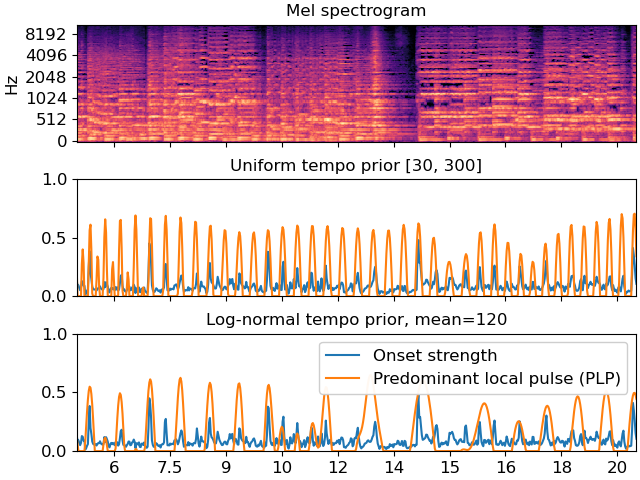Caution
You're reading an old version of this documentation. If you want up-to-date information, please have a look at 0.10.2.
librosa.beat.plp
- librosa.beat.plp(*, y=None, sr=22050, onset_envelope=None, hop_length=512, win_length=384, tempo_min=30, tempo_max=300, prior=None)[source]
Predominant local pulse (PLP) estimation. [1]
The PLP method analyzes the onset strength envelope in the frequency domain to find a locally stable tempo for each frame. These local periodicities are used to synthesize local half-waves, which are combined such that peaks coincide with rhythmically salient frames (e.g. onset events on a musical time grid). The local maxima of the pulse curve can be taken as estimated beat positions.
This method may be preferred over the dynamic programming method of
beat_trackwhen either the tempo is expected to vary significantly over time. Additionally, sinceplpdoes not require the entire signal to make predictions, it may be preferable when beat-tracking long recordings in a streaming setting.- Parameters:
- ynp.ndarray [shape=(…, n)] or None
audio time series. Multi-channel is supported.
- srnumber > 0 [scalar]
sampling rate of
y- onset_envelopenp.ndarray [shape=(…, n)] or None
(optional) pre-computed onset strength envelope
- hop_lengthint > 0 [scalar]
number of audio samples between successive
onset_envelopevalues- win_lengthint > 0 [scalar]
number of frames to use for tempogram analysis. By default, 384 frames (at
sr=22050andhop_length=512) corresponds to about 8.9 seconds.- tempo_min, tempo_maxnumbers > 0 [scalar], optional
Minimum and maximum permissible tempo values.
tempo_maxmust be at leasttempo_min.Set either (or both) to None to disable this constraint.
- priorscipy.stats.rv_continuous [optional]
A prior distribution over tempo (in beats per minute). By default, a uniform prior over
[tempo_min, tempo_max]is used.
- Returns:
- pulsenp.ndarray, shape=[(…, n)]
The estimated pulse curve. Maxima correspond to rhythmically salient points of time.
If input is multi-channel, one pulse curve per channel is computed.
Examples
Visualize the PLP compared to an onset strength envelope. Both are normalized here to make comparison easier.
>>> y, sr = librosa.load(librosa.ex('brahms')) >>> onset_env = librosa.onset.onset_strength(y=y, sr=sr) >>> pulse = librosa.beat.plp(onset_envelope=onset_env, sr=sr) >>> # Or compute pulse with an alternate prior, like log-normal >>> import scipy.stats >>> prior = scipy.stats.lognorm(loc=np.log(120), scale=120, s=1) >>> pulse_lognorm = librosa.beat.plp(onset_envelope=onset_env, sr=sr, ... prior=prior) >>> melspec = librosa.feature.melspectrogram(y=y, sr=sr)
>>> import matplotlib.pyplot as plt >>> fig, ax = plt.subplots(nrows=3, sharex=True) >>> librosa.display.specshow(librosa.power_to_db(melspec, ... ref=np.max), ... x_axis='time', y_axis='mel', ax=ax[0]) >>> ax[0].set(title='Mel spectrogram') >>> ax[0].label_outer() >>> ax[1].plot(librosa.times_like(onset_env), ... librosa.util.normalize(onset_env), ... label='Onset strength') >>> ax[1].plot(librosa.times_like(pulse), ... librosa.util.normalize(pulse), ... label='Predominant local pulse (PLP)') >>> ax[1].set(title='Uniform tempo prior [30, 300]') >>> ax[1].label_outer() >>> ax[2].plot(librosa.times_like(onset_env), ... librosa.util.normalize(onset_env), ... label='Onset strength') >>> ax[2].plot(librosa.times_like(pulse_lognorm), ... librosa.util.normalize(pulse_lognorm), ... label='Predominant local pulse (PLP)') >>> ax[2].set(title='Log-normal tempo prior, mean=120', xlim=[5, 20]) >>> ax[2].legend()
PLP local maxima can be used as estimates of beat positions.
>>> tempo, beats = librosa.beat.beat_track(onset_envelope=onset_env) >>> beats_plp = np.flatnonzero(librosa.util.localmax(pulse)) >>> import matplotlib.pyplot as plt >>> fig, ax = plt.subplots(nrows=2, sharex=True, sharey=True) >>> times = librosa.times_like(onset_env, sr=sr) >>> ax[0].plot(times, librosa.util.normalize(onset_env), ... label='Onset strength') >>> ax[0].vlines(times[beats], 0, 1, alpha=0.5, color='r', ... linestyle='--', label='Beats') >>> ax[0].legend() >>> ax[0].set(title='librosa.beat.beat_track') >>> ax[0].label_outer() >>> # Limit the plot to a 15-second window >>> times = librosa.times_like(pulse, sr=sr) >>> ax[1].plot(times, librosa.util.normalize(pulse), ... label='PLP') >>> ax[1].vlines(times[beats_plp], 0, 1, alpha=0.5, color='r', ... linestyle='--', label='PLP Beats') >>> ax[1].legend() >>> ax[1].set(title='librosa.beat.plp', xlim=[5, 20]) >>> ax[1].xaxis.set_major_formatter(librosa.display.TimeFormatter())

